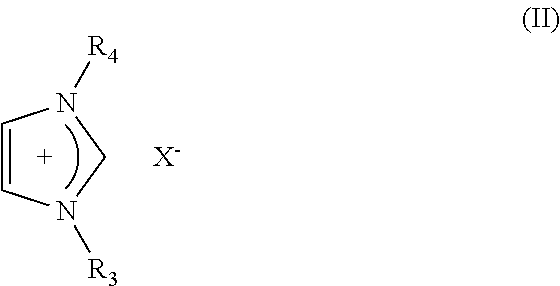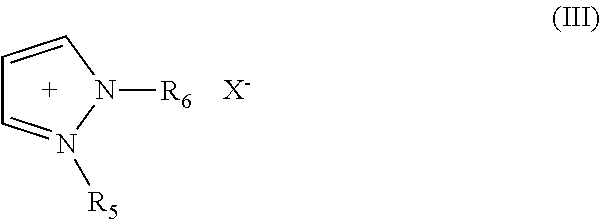Electric Al-Zr Alloy Plating Bath Using Room Temperature Molten Salt Bath and Plating Method Using the Same
- Summary
- Abstract
- Description
- Claims
- Application Information
AI Technical Summary
Benefits of technology
Problems solved by technology
Method used
Image
Examples
examples 1 to 9
[0044]Toluene as an aromatic organic solvent was blended with a bath prepared by melt blending AlCl3 (841 g / L) and 1-methyl-3-propylimidazolium bromide (64.7 g / L) (at a molar ratio of 2:1) and then zirconium chloride was added to the resulting blend to thus give an electric Al—Zr alloy-plating bath. Then an iron plate (thickness: 0.5 mm) used as a cathode was subjected to pretreatments. More specifically, the iron plate was degreased with an alkali, washed through the alkali-electrolysis, then washed with an acid, washed with water and then with ethyl alcohol and finally dried. Using the foregoing iron plate as a cathode and an aluminum plate (purity 99.9%) as an anode, these electrodes were immersed in the foregoing electric Al—Zr alloy-plating bath maintained at 50° C. in a dry nitrogen gas atmosphere for 5 minutes and then the Al—Zr alloy-plating was carried out using a direct current or a pulsed current (duty ratio=1:1; ON time: 10 ms; and OFF time: 10 ms). In this respect, the ...
examples 10 to 15
[0045]Zirconium chloride (5 g / L) was added to a bath prepared by melt blending AlCl3 (841 g / L) and 1-methyl-3-propylimidazolium bromide (64.7 g / L) (at a molar ratio of 2:1) and further an organic polymer and a brightening agent were added to the resulting mixture to thus give an electric Al—Zr alloy-plating bath. Then an iron plate (thickness: 0.5 mm) used as a cathode was subjected to pretreatments. More specifically, the iron plate was degreased with an alkali, washed through the alkali-electrolysis, then washed with an acid, washed with water and then with ethyl alcohol and finally dried. Using the foregoing iron plate as a cathode and an aluminum plate (purity 99.9%) as an anode, these electrodes were immersed in the foregoing electric Al—Zr alloy-plating bath maintained at 50° C. in a dry nitrogen gas atmosphere for 5 minutes and then the Al—Zr alloy-plating was carried out using a direct current. In this respect, the plating bath was stirred using a stirrer. In these Examples,...
PUM
| Property | Measurement | Unit |
|---|---|---|
| Percent by mass | aaaaa | aaaaa |
| Concentration | aaaaa | aaaaa |
| Density | aaaaa | aaaaa |
Abstract
Description
Claims
Application Information
 Login to View More
Login to View More - R&D
- Intellectual Property
- Life Sciences
- Materials
- Tech Scout
- Unparalleled Data Quality
- Higher Quality Content
- 60% Fewer Hallucinations
Browse by: Latest US Patents, China's latest patents, Technical Efficacy Thesaurus, Application Domain, Technology Topic, Popular Technical Reports.
© 2025 PatSnap. All rights reserved.Legal|Privacy policy|Modern Slavery Act Transparency Statement|Sitemap|About US| Contact US: help@patsnap.com



